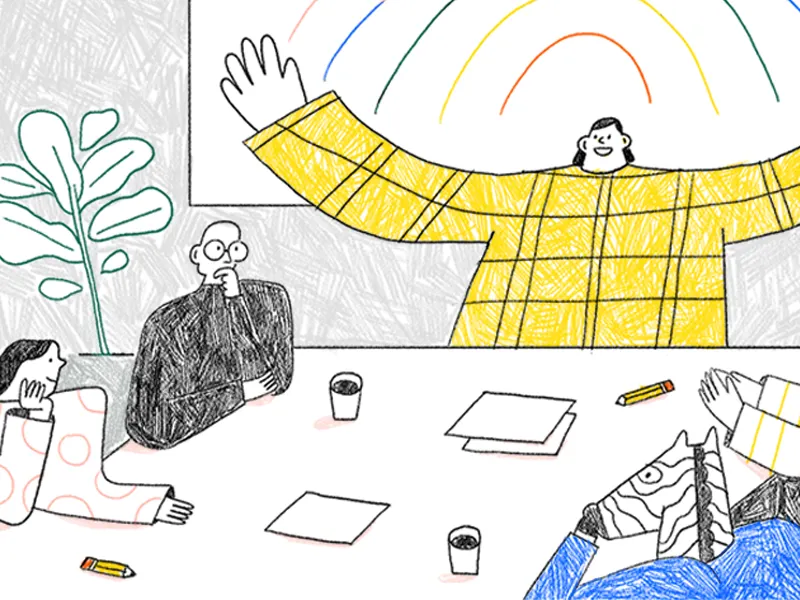In this post, Jess Eddy shares the strategies you need to effectively present your product designs to non-designers, clients, or other stakeholders so you can walk away with actionable feedback.
As a designer, you spend a lot of time presenting and reviewing work with others. How do you get the best results? How do you ensure that you’re communicating to the best of your ability?
I’ve been presenting work to clients and colleagues for a while now. Over the years, I’ve learned and employed some essential habits so that presentations go smoothly and I get the best from the group.
When you present work, part of your job is to set others up for success in giving feedback. It’s helpful to keep in mind that most people do not know how to provide useful feedback. And other people just need reminders sometimes.
As a designer, it’s very easy to forget that people do not share your domain knowledge; this is a mistake that I still make sometimes. Because they don’t share your domain knowledge, certain things require a little more setup or explaining.
In this post, I’ll share my best tips on how to pitch and present your design work to non-designers so you can walk away with quality, actionable feedback.
1. Before you do anything: provide context on the problem(s) you are solving!
Designers are problem solvers that just happen to solve problems via design. When you present a screen or prototype, the problem you’re solving may not be obvious, and the problem is the number one reason we are all in a room together reviewing work.
Explain the problem and make it visible to better frame your design work. When you frame your work around a problem, the people you’re presenting to will view it through this lens, and this is necessary to get good feedback.
2. Make it clear who has the problem you’re solving
When we design, we design for people. Often within a product or a feature that we’re designing, there are different people with varying needs. When you present your work, specifically within the problems you’re solving, make it clear who the work serves. You’re designing for the people who are not in the room to make sure they’re represented.
I am the lead product designer at an edTech startup in Sydney. We have developed a collaborative online learning environment where students engage in learning sessions with tutors. Not only do we have two very different types of users (tutors and students), we have many kinds of students, grades 3-12 students in Chemistry, English, and Maths.
We have managed to deliver a product experience that caters well to all students, but some features I design and the team develops are really impactful in the context of a particular subject and age group. I make sure to communicate this to my team.
3. Make it clear what your solution(s) allow people to do
When we design, it’s usually (and hopefully!) to add value to a customer and or make customers’ lives better in some way. We do this by designing the right features for them in the right way. There is this notion of making customers feel like superheroes or giving them powers that they didn’t have before.
Doing this is a win-win as it makes customers happy, which in turn is good for business. Make sure you communicate what value your design brings to the customers you are creating solutions for.
4. Communicate the constraints
I love Mike Monteiro’s definition of design:
“Design is the intentional solution to a problem within a set of constraints.”
Bingo. If you like it too, you should print it out and hang it on the wall.
The context in many areas is so crucial to successfully present and communicate work. There are always constraints when we design, and constraints can be technical, time and effort related, business motivated, and more. The constraints move your designs into specific directions, and it’s helpful to illuminate these paths for the rest of your team.
People (non-designers and designers) will naturally offer up alternative solutions to the one(s) you designed. It’s human nature, and it’s part of working together, and we can’t get upset about it.
But what you can do is communicate why you made the design decisions that you did given the constraints. When you do this before receiving design feedback, the people around you are less likely to present alternative solutions that don’t work because they understand the limitations.
Everything on the screen has a purpose and a reason for being there. Only you know why you made specific design decisions, and it’s your job to communicate the reasoning to everyone as well as be ready to answer when someone asks.
5. Explain UX jargon
Again, it’s easy to forget that not everyone shares your domain knowledge. If there are user experience (UX) terms that need to be understood to make sense of the work you’re presenting as a whole, make sure they’re clear.
For example, if you’re talking about a topic like Web Accessibility, which has many layers and complexities, make sure to specify exactly what part of Accessibility your web design supports. In UX, we also have many activities that do similar things, such as journeys, flows, and maps. Clarify the purpose of the activity and how it helps and informs the work you do.
Remember that as designers, we are much of the time, also facilitators and teachers!
I polled my Twitter community and got these responses when asked, what’s your favorite bit of UX jargon that you have to explain:
- Usability analysis
- Customer journey map
- Micro-interactions
- Cognitive walkthrough
- Cognitive load
- Mental model
- Heuristic evaluation
- Affordance
6. Provide a format for feedback
Often times, when people provide design feedback, they will suggest a different solution to the one you’re presenting. In these situations I always ask that people also (and ideally first) provide the motivation for that bit of feedback and the specific problem they’re trying to solve or ask them to describe what about the current solution doesn’t work for them.
Solutions are meaningless without the proper context and an understanding of where they are coming from. It’s easy to throw out solutions, it’s much harder to grasp the real problem and the best solution for it.
7. Sometimes you need to show your design process
If you’ve worked with a team or a client for a while, your design process is something that comes up once or twice in the beginning and not much after that. There are times, though when you need to show the process you went through.
Maybe you tried many different suggestions from the team or major stakeholders that didn’t work, and you need to show them, or perhaps you want to justify why you made a significant change to the branding or broke a design pattern.
Showing what led up to the decision you made can let your audience see the solution as you do.
8. Convey the format of the meeting
If you have a particular format for the meeting, make sure everyone knows. When I was consulting, I used to print out the agenda for some meetings and give time estimates on how long certain parts of the meeting might take. This is overkill for most meetings as a lot of meetings just don’t require this level of detail.
Perhaps you would like to walk through the entire presentation before opening up the floor for feedback. Maybe you want to invite people to ask specific questions along the way (which is usually necessary to clarify and cement understanding). At any rate, whatever your format is, tell people at the beginning of the meeting!
9. Focus on storytelling but avoid long lead-in
Weaving your work into a larger story can help you set the context, tone, and prepare the audience for the solutions you’re about to present, as is hitting on the key points you’re going to make. However, it’s easy to lose the attention of the people in the room, and they’re probably very eager to see your work as well. Don’t make the wait too long and consider how you lead into it.
We can look to journalism for different ways of setting up a story. One method is an Inverted Pyramid, and it’s where you state the most important information upfront. Conversely, “the opposite”—the failure to mention the most important, interesting or attention-grabbing elements of a story in the opening paragraphs, is called “burying the lead.”
10. Break your UI down into component parts
If you’re presenting a large piece of work, it can sometimes be overwhelming for the group as there is just so much to take in. Consider breaking down the UI into its component parts and presenting them individually before showing the whole thing. Especially if there are parts of the UI that underpin the whole or that are essential or complex enough to discuss separately. This approach will allow the group to have a solid understanding of how things work once they see the entire UI.
11. Don’t back down from difficult people
Hopefully, you work in a supportive and caring environment. Regardless, sometimes things just get tense, and certain people in the room can be difficult. Perhaps they are aggressive or overly assertive for whatever reason. As the presenter, you need to keep it professional and always stay calm, but that doesn’t mean that you need to accept or be bulldozed by their behavior.
Stand up for yourself by being direct. Be direct by responding with the facts and keep it clear and concise. If someone is interrupting you, ask them to please not interrupt you and finish your point. Depending on the size of the room, your proximity to the person, and if you’re standing or not, you can always walk away from the person to draw attention elsewhere.
You can do this!
Presenting work can be really fun and when you do it well, it’s a great confidence builder.
Take a little time to think about who is in the room as well as the work you’re presenting and how you want to present to them. Set up your design solutions by focusing on the problem you’re solving and for whom. Think about how to capture people’s attention at the beginning of the presentation and what the right format is for the work you’re showing. Create a feedback process in which you are very clear on the type of feedback you’re looking for and help people give better feedback by providing them a format for doing so.

Jess Eddy is a digital product designer and runs UI Goodies, a directory of resources for designers. As part of UI Goodies, she also produces Guides to help you find the best resources based on your needs. Jess lives in Sydney, Australia, and works in education tech, assisting students in grades 3-12 to learn online.
Find more Process stories on our blog Courtside. Have a suggestion? Contact stories@dribbble.com.














